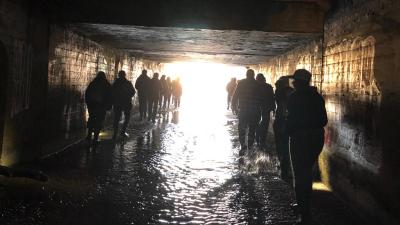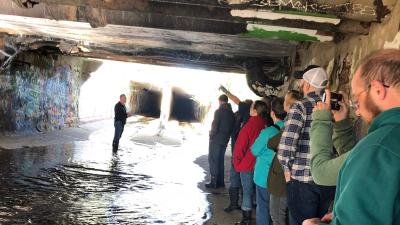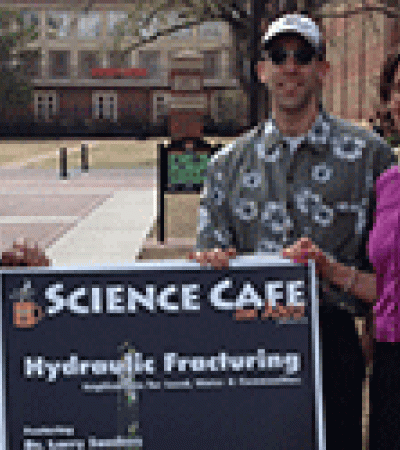Enticing patrons to attend lectures on climate change and sustainability can be a real challenge. It’s hard to deny: these topics can be a real downer.
But there are ways to make learning about the environment fun. This was my goal when I set out to create my library’s Earth Day programming last year.
Believing that experiential learning is more fun and creates a bigger impact, I set out to host a program that would get our patrons outside to experience an environmental topic firsthand. The result was an underground creek tour that proved to be a fantastic addition to our Earth Day lineup.

“Never see a storm drain the same way”
Planning an offsite program on a topic that I was passionate about, but knew little about, meant that my first step was researching local organizations to partner with. One of our branch managers suggested a local nonprofit, the Watershed Committee of the Ozarks (WCO).
When I visited WCO’s website, I came across a program they already offered called the Jordan Creek Underground Tour. “It’s an adventure similar to a cave tour,” the website said. “Once you have walked through the graffiti covered passages of the once pristine Jordan Creek, you and your group will never see a storm drain the same way.”
I knew our adult crowd would be excited for such a unique opportunity, and best of all, they would learn more than they bargained for about the history and health of Springfield’s waterways. Another bonus: WCO offered the tour to the public at no cost.
Planning to go underground
I reached out to WCO’s program coordinator, Jeff Birchler, six months in advance of my desired program date. He jumped at the chance to partner with the library. (He later said it was helpful that we were planning so far in advance as Earth Day is one of their busiest times.) Once we established the partnership, we got down to planning.
First we needed to agree on a program description. It was critical that we describe the program accurately so our patrons would know what they were getting into; the tour required climbing down a ladder and wading in up to a foot water for three quarters of a mile.
We made sure to mention that patrons should bring waterproof footwear and a flashlight, although WCO would provide this equipment for anyone who showed up ill-prepared. This information was included in all promotional materials, including our quarterly event calendar. We also confirmed that WCO would provide waiver forms for all participants.
Despite our partner’s busy schedule, we were able to book the program for the Friday before Earth Day with two different time slots during mid- and late-afternoon. We required registration, as each tour was limited to 20 participants.
Both tours filled up almost immediately. One of the tours even had a wait list of 13 people! We had a few no-shows and ended up with 36 participants on the day of the program.

The day of the tour
As participants arrived, they signed waivers and grabbed rubber boots and flashlights if they didn’t already have them. While we were still above ground, Jeff began the tour with a brief overview of the history of the creek.
Participants then climbed down a short ladder into the creek, which led into the underground portion of the waterway. As we walked through the tunnel, Jeff spoke about various points of interest, the overall health of local waterways and what was being done to rejuvenate the creek.
During the tour, participants sloshed through water and relied on their flashlights to light the way. The walls were covered with vibrant graffiti, and participants were eager to take photos of the rarely seen art. Once the group resurfaced, we walked back to the starting point, following the creek above ground and noting all the storm drains we had seen from below.
We did face one unexpected challenge. Despite our best efforts to warn patrons about the physical nature of the tour, an older gentleman struggled along the way. It became apparent about halfway through that he needed to head back. Jeff led the rest of the tour while I and a WCO staffer got him safely out of the tunnel.
Feedback
The feedback patrons gave us after the program was fantastic. A few couples mentioned that this had been their date-night activity, and one participant was thrilled to go down into the tunnel as her father had helped build portions of it. Patrons responded enthusiastically to the adventurous nature of the tour and learned so much along the way!
The WCO staff were also thrilled to reach new segments of the community. WCO mainly leads tours for high school students, so having two full tours of adults was a great success for both parties. They were adamant that the library and WCO partner together for future programs.
The tour was also a fit for our Earth Day mission. Participants had the chance to think about our city’s reliance on our waterways and to reflect on how their actions now impact the future of our water safety.
Haley White is a reference librarian at Springfield-Greene County Library District. This blog post is part of a series exploring programming for Earth Day 2020.



